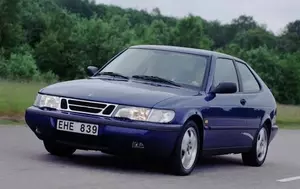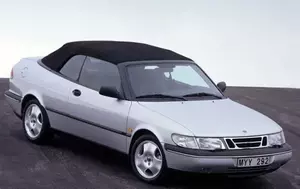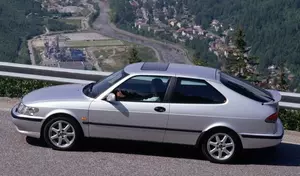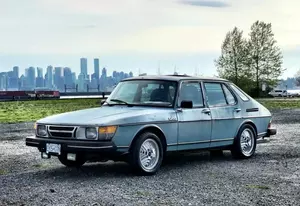


| Vehicle | Curb weight | Difference from world's smallest | Weight to power ratio | 0—60 mph acceleration ratio | Consumption ratio |
|---|---|---|---|---|---|
| 2.5 - 24 V6 |
1345 kg / 2966 lbs |
920 kg (2029 lbs) heavier | 8 kg to 1 hp | 155 kg/s (342 lbs/s) |
148 kg/L (326 lbs/L) |
| 2.0 - 16 Turbo |
1330 kg / 2933 lbs |
905 kg (1996 lbs) heavier | 7 kg to 1 hp | 164 kg/s (362 lbs/s) |
156 kg/L (344 lbs/L) |
| 2.0i |
1315 kg / 2900 lbs |
890 kg (1963 lbs) heavier | 10 kg to 1 hp | 125 kg/s (276 lbs/s) |
141 kg/L (311 lbs/L) |
| 2.3 - 16 |
1320 kg / 2911 lbs |
895 kg (1974 lbs) heavier | 9 kg to 1 hp | 139 kg/s (306 lbs/s) |
152 kg/L (335 lbs/L) |
| Vehicle | 2.5 - 24 V6 |
|---|---|
| Curb weight |
1345 kg / 2966 lbs |
| Difference from world's smallest | 920 kg (920 lbs) heavier |
| Weight to power ratio | 8 kg to 1 hp |
| 0—60 mph acceleration ratio | 155 kg/s (342 lbs/s) |
| Consumption ratio |
148 kg/L (326 lbs/L) |
| Vehicle | 2.0 - 16 Turbo |
| Curb weight |
1330 kg / 2933 lbs |
| Difference from world's smallest | 905 kg (905 lbs) heavier |
| Weight to power ratio | 7 kg to 1 hp |
| 0—60 mph acceleration ratio | 164 kg/s (362 lbs/s) |
| Consumption ratio |
156 kg/L (344 lbs/L) |
| Vehicle | 2.0i |
| Curb weight |
1315 kg / 2900 lbs |
| Difference from world's smallest | 890 kg (890 lbs) heavier |
| Weight to power ratio | 10 kg to 1 hp |
| 0—60 mph acceleration ratio | 125 kg/s (276 lbs/s) |
| Consumption ratio |
141 kg/L (311 lbs/L) |
| Vehicle | 2.3 - 16 |
| Curb weight |
1320 kg / 2911 lbs |
| Difference from world's smallest | 895 kg (895 lbs) heavier |
| Weight to power ratio | 9 kg to 1 hp |
| 0—60 mph acceleration ratio | 139 kg/s (306 lbs/s) |
| Consumption ratio |
152 kg/L (335 lbs/L) |

| Vehicle | Curb weight | Difference from world's smallest | Weight to power ratio | 0—60 mph acceleration ratio | Consumption ratio |
|---|---|---|---|---|---|
| 2.0 - 16 Turbo |
1390 kg / 3065 lbs |
965 kg (2128 lbs) heavier | 8 kg to 1 hp | 172 kg/s (379 lbs/s) |
164 kg/L (362 lbs/L) |
| 2.0i |
1370 kg / 3021 lbs |
945 kg (2084 lbs) heavier | 10 kg to 1 hp | 130 kg/s (287 lbs/s) |
147 kg/L (324 lbs/L) |
| 2.3 - 16 |
1375 kg / 3032 lbs |
950 kg (2095 lbs) heavier | 9 kg to 1 hp | 145 kg/s (320 lbs/s) |
158 kg/L (348 lbs/L) |
| 2.5 - 24 V6 |
1400 kg / 3087 lbs |
975 kg (2150 lbs) heavier | 8 kg to 1 hp | 161 kg/s (355 lbs/s) |
154 kg/L (340 lbs/L) |
| Vehicle | 2.0 - 16 Turbo |
|---|---|
| Curb weight |
1390 kg / 3065 lbs |
| Difference from world's smallest | 965 kg (965 lbs) heavier |
| Weight to power ratio | 8 kg to 1 hp |
| 0—60 mph acceleration ratio | 172 kg/s (379 lbs/s) |
| Consumption ratio |
164 kg/L (362 lbs/L) |
| Vehicle | 2.0i |
| Curb weight |
1370 kg / 3021 lbs |
| Difference from world's smallest | 945 kg (945 lbs) heavier |
| Weight to power ratio | 10 kg to 1 hp |
| 0—60 mph acceleration ratio | 130 kg/s (287 lbs/s) |
| Consumption ratio |
147 kg/L (324 lbs/L) |
| Vehicle | 2.3 - 16 |
| Curb weight |
1375 kg / 3032 lbs |
| Difference from world's smallest | 950 kg (950 lbs) heavier |
| Weight to power ratio | 9 kg to 1 hp |
| 0—60 mph acceleration ratio | 145 kg/s (320 lbs/s) |
| Consumption ratio |
158 kg/L (348 lbs/L) |
| Vehicle | 2.5 - 24 V6 |
| Curb weight |
1400 kg / 3087 lbs |
| Difference from world's smallest | 975 kg (975 lbs) heavier |
| Weight to power ratio | 8 kg to 1 hp |
| 0—60 mph acceleration ratio | 161 kg/s (355 lbs/s) |
| Consumption ratio |
154 kg/L (340 lbs/L) |

| Vehicle | Curb weight | Difference from world's smallest | Weight to power ratio | 0—60 mph acceleration ratio | Consumption ratio |
|---|---|---|---|---|---|
| 2.3 -16 |
1300 kg / 2867 lbs |
875 kg (1930 lbs) heavier | 9 kg to 1 hp | 137 kg/s (302 lbs/s) |
149 kg/L (329 lbs/L) |
| 2.0 - 16 Turbo |
1310 kg / 2889 lbs |
885 kg (1952 lbs) heavier | 7 kg to 1 hp | 162 kg/s (357 lbs/s) |
154 kg/L (340 lbs/L) |
| 2.0i |
1295 kg / 2855 lbs |
870 kg (1918 lbs) heavier | 10 kg to 1 hp | 123 kg/s (271 lbs/s) |
139 kg/L (306 lbs/L) |
| 2.5 24 V6 |
1325 kg / 2922 lbs |
900 kg (1985 lbs) heavier | 8 kg to 1 hp | 152 kg/s (335 lbs/s) |
146 kg/L (322 lbs/L) |
| Vehicle | 2.3 -16 |
|---|---|
| Curb weight |
1300 kg / 2867 lbs |
| Difference from world's smallest | 875 kg (875 lbs) heavier |
| Weight to power ratio | 9 kg to 1 hp |
| 0—60 mph acceleration ratio | 137 kg/s (302 lbs/s) |
| Consumption ratio |
149 kg/L (329 lbs/L) |
| Vehicle | 2.0 - 16 Turbo |
| Curb weight |
1310 kg / 2889 lbs |
| Difference from world's smallest | 885 kg (885 lbs) heavier |
| Weight to power ratio | 7 kg to 1 hp |
| 0—60 mph acceleration ratio | 162 kg/s (357 lbs/s) |
| Consumption ratio |
154 kg/L (340 lbs/L) |
| Vehicle | 2.0i |
| Curb weight |
1295 kg / 2855 lbs |
| Difference from world's smallest | 870 kg (870 lbs) heavier |
| Weight to power ratio | 10 kg to 1 hp |
| 0—60 mph acceleration ratio | 123 kg/s (271 lbs/s) |
| Consumption ratio |
139 kg/L (306 lbs/L) |
| Vehicle | 2.5 24 V6 |
| Curb weight |
1325 kg / 2922 lbs |
| Difference from world's smallest | 900 kg (900 lbs) heavier |
| Weight to power ratio | 8 kg to 1 hp |
| 0—60 mph acceleration ratio | 152 kg/s (335 lbs/s) |
| Consumption ratio |
146 kg/L (322 lbs/L) |

| Vehicle | Curb weight | Difference from world's smallest | Weight to power ratio | 0—60 mph acceleration ratio | Consumption ratio |
|---|---|---|---|---|---|
| 2.0i 16V |
1200 kg / 2646 lbs |
775 kg (1709 lbs) heavier | 10 kg to 1 hp | 90 kg/s (198 lbs/s) |
108 kg/L (238 lbs/L) |
| 2.0 i 16V Turbo |
1190 kg / 2624 lbs |
765 kg (1687 lbs) heavier | 8 kg to 1 hp | 96 kg/s (212 lbs/s) |
101 kg/L (223 lbs/L) |
| Vehicle | 2.0i 16V |
|---|---|
| Curb weight |
1200 kg / 2646 lbs |
| Difference from world's smallest | 775 kg (775 lbs) heavier |
| Weight to power ratio | 10 kg to 1 hp |
| 0—60 mph acceleration ratio | 90 kg/s (198 lbs/s) |
| Consumption ratio |
108 kg/L (238 lbs/L) |
| Vehicle | 2.0 i 16V Turbo |
| Curb weight |
1190 kg / 2624 lbs |
| Difference from world's smallest | 765 kg (765 lbs) heavier |
| Weight to power ratio | 8 kg to 1 hp |
| 0—60 mph acceleration ratio | 96 kg/s (212 lbs/s) |
| Consumption ratio |
101 kg/L (223 lbs/L) |

| Vehicle | Curb weight | Difference from world's smallest | Weight to power ratio | 0—60 mph acceleration ratio | Consumption ratio |
|---|---|---|---|---|---|
| 2.0 EMS |
1174 kg / 2589 lbs |
749 kg (1652 lbs) heavier | 10 kg to 1 hp | - | - |
| 2.0 c |
1214 kg / 2677 lbs |
789 kg (1740 lbs) heavier | 11 kg to 1 hp | - | - |
| 2.0i 16V |
1200 kg / 2646 lbs |
775 kg (1709 lbs) heavier | 10 kg to 1 hp | 90 kg/s (198 lbs/s) |
108 kg/L (238 lbs/L) |
| 2.0 i 16V Turbo |
1315 kg / 2900 lbs |
890 kg (1963 lbs) heavier | 8 kg to 1 hp | 158 kg/s (348 lbs/s) |
129 kg/L (284 lbs/L) |
| Vehicle | 2.0 EMS |
|---|---|
| Curb weight |
1174 kg / 2589 lbs |
| Difference from world's smallest | 749 kg (749 lbs) heavier |
| Weight to power ratio | 10 kg to 1 hp |
| 0—60 mph acceleration ratio | - |
| Consumption ratio | - |
| Vehicle | 2.0 c |
| Curb weight |
1214 kg / 2677 lbs |
| Difference from world's smallest | 789 kg (789 lbs) heavier |
| Weight to power ratio | 11 kg to 1 hp |
| 0—60 mph acceleration ratio | - |
| Consumption ratio | - |
| Vehicle | 2.0i 16V |
| Curb weight |
1200 kg / 2646 lbs |
| Difference from world's smallest | 775 kg (775 lbs) heavier |
| Weight to power ratio | 10 kg to 1 hp |
| 0—60 mph acceleration ratio | 90 kg/s (198 lbs/s) |
| Consumption ratio |
108 kg/L (238 lbs/L) |
| Vehicle | 2.0 i 16V Turbo |
| Curb weight |
1315 kg / 2900 lbs |
| Difference from world's smallest | 890 kg (890 lbs) heavier |
| Weight to power ratio | 8 kg to 1 hp |
| 0—60 mph acceleration ratio | 158 kg/s (348 lbs/s) |
| Consumption ratio |
129 kg/L (284 lbs/L) |